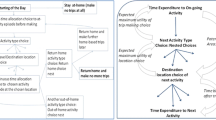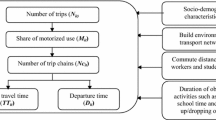Abstract
This paper presents an empirical analysis of non-workers’ activity-travel behaviour from Bangalore city, India. The paper builds a causal model—to describe the relationships among socio-demographics, activity-participation, and travel behaviour of non-workers—following structural equation modelling methodology. The results indicate that in-home maintenance activity-duration drives the time allocation decisions of non-workers. The model also shows the presence of ‘time-budget’ effects i.e., excess travel time cuts into in-hhome discretionary activity duration, implying the trade-off between daily travel time and in-home discretionary activity duration. The out-of-home activity durations of non-workers are found to be insensitive to travel time—an important finding of this research. The model also suggests that mixed residential development reduce travel distance and indirectly contribute to more trips. An indirect effect of mixed residential development on daily travel distance offsets the direct effect, which leads to a limited total effect of this variable on travel distance. The basic model was expanded further by separating the time spent on others’ activity (children and elders) from in-home maintenance activity duration. The stable model reveals that the time spent on others’ activity also influences in-home and out-of-home activities, and travel behaviour. This indicates that the time spent on others’ activity is an important time allocation of its own.


Similar content being viewed by others
Notes
Activity-travel behaviour of school-going children can be analysed and modelled in a similar framework as that for workers. See Bowman et al. (1998) for more details.
According to Bangalore Development Authority (2007), main features of such areas are: “…where employment, shopping and residential land uses will be integrated in a compact urban form, at higher development intensities and will be pedestrian-oriented and highly accessible by public transit”.
The framework in Fig. 1 was initially estimated with tour-level travel behaviour indicators (no. of stops/tour, daily tour distance etc.). However, the model fit was poor and many of the relationships were counter intuitive.
References
Arasan, V., Rengaraju, V., Rao, K.: Characteristics of trips by foot and bicycle modes in Indian city. J. Transp. Eng. 120(2), 283–294 (1994)
Arasan, V., Rengaraju, V., Rao, K.: Trip characteristics of travellers without vehicles. J. Transp. Eng. 122(1), 76–81 (1996)
Arasan, V., Rengaraju, V., Rao, K.: Mode choice for work journeys of urban travellers owning motorised vehicles in India. Transp. Plan. Technol. 22, 27–45 (1998)
Aguiléra, A., Massot, M.H., Proulhac, L.: Exploring the relationship between work and travel behaviour on weekdays. Transp. Res. Rec. 2135(1), 69–77 (2009)
Alexander, B.: On variability and heterogeneity of day-to-day travel. Dissertation, Kyoto University, Kyoto (2007)
Azari, K.A., Arintono, S., Hamid, H., Davoodi, S.R.: Evaluation of demand for different trip purposes under various congestion-pricing scenarios. J. Transp. Geogr. 29, 43–51 (2013)
Banerjee, A., Pendyala, R.M.: Relationships between work and non-work activity and travel durations in a developing country context. In: Proceedings of the 86th Annual Meeting of Transportation Research Board, Washington D.C. (2007)
Banerjee, A., Ye, X., Pendyala, R.M.: Understanding travel time expenditures around the world: exploring the notion of a travel time frontier. Transportation 34(1), 51–65 (2007)
Bangalore Development Authority: Draft Masterplan-2015. Final report, Bangalore Development Authority (2007)
Bangalore Metropolitan Region Development Authority: Comprehensive traffic and transport plan for Bangalore. Final report (2010)
Bentler, P.M., Freeman, E.H.: Tests for stability in linear structural equation systems. Psychometrika 45, 143–145 (1983)
Bhat, C., Misra, R.: Comprehensive activity travel pattern modelling system for non-workers with empirical focus on organization of activity episodes. Transp. Res. Rec. 1777(1), 16–24 (2001)
Bowman, J.L.: Day activity schedule approach to travel demand analysis. Dissertation, Massachusetts Institute of Technology, Cambridge (1998)
Bowman, J.L., Bradley, M., Shiftan, Y., Lawton, K.T., Ben-Akiva M.: Demonstration of an activity-based model system for Portland. In: Proceedings of the 8th World Conference on Transport Research, Antwerp (1998)
Bricka, S.: Trip chaining: linking the influences and implications. Dissertation, University of Texas at Austin, Austin (2008)
Castaigne, M., Cornelis, E., Frederix, R., Tampere, C., Toint, P., Viti, F., Walle, F.: Behaviour and mobility within the week BMW. Final report, Belgian Science Policy, Research Programme Science for a Sustainable Development, Brussels (2009)
Census of India: Population Projections for India and States 2001–2026. Report of the Technical Group on Population Projection Constituted by the National Commission on Population (2001)
Census of India: Figures at a Glance—Karnataka. Primary Census Abstract (In CD-Rom) (2011)
Central Statistics Office: Situation analysis of elderly in India. Report, Ministry of Statistics and Programme Implementation, Government of India (2011)
Chen, C., McKnight, C.E.: Does the built environment makes a difference? Additional evidence from the daily activity and travel behaviour of homemakers living in New York City and suburbs. J. Transp. Geogr. 15(5), 380–395 (2007)
Choo, S., Mokhtarian, P.L.: Telecommunications and travel demand, and supply: aggregate structural equation models for the US. Transp. Res. 41A, 4–18 (2007)
Chowdhury, S.R.: Livelihood and income: informality and poverty in Bangalore’s slums. South Asia Work in Research Progress. http://www.southasia.ox.ac.uk/south-asia-work-progress-research-papers (2011). Accessed 12 Jan 2014
Cirillo, C., Toint, P.L.: A multinational comparison of travel behaviour using an activity-based approach. Transportation Research Group, FUNDP, Namur (2001)
Dharmowijoyo, D.B., Susilo, Y.O., Karlström, A.: The day-to-day variability in travellers’ activity-travel patterns in the jakarta metropolitan area (JMA). In: Proceedings of the 94th Annual Meeting of Transportation Research Board, Washington D.C. (No. 14-1314) (2014)
Fox, J.: Linear Statistical Models and Related Methods. Wiley, New York, ISBN-10: 0471099139 (1984)
Golob, T.F., McNally, M.G.: A model of household interactions in activity participation and the derived demand for travel. Transp. Res. 31B, 177–194 (1997)
Golob, T.F.: A model of household demand for activity participation and mobility. In: Gärling, T., Laitilla, T., Westin, K. (eds.) Theoretical Foundations of Travel Choice Modelling, pp. 365–398. Pergamon, Oxford (1997)
Golob, T.F., Bradley, M.A., Polak, J.M.: Travel and activity participation as influenced by car availability and use. Working Paper No. 286, University of California Transportation Centre, Berkeley (1995)
Golob, T.F.: A simultaneous model of household activity participation and trip chain generation. Transp. Res. 34B, 355–376 (2000)
Gould, J., Golob, T.F.: Shopping without travel or travel without shopping: an investigation of electronic home shopping. Transp. Rev. 17, 355–376 (1997)
Hensher, D.A., Rose, J.M.: Development of commuter and non-commuter mode choice models for the assessment of new public transport infrastructure projects: a case study. Transp. Res. A 41(5), 428–443 (2007)
Independent Pricing and Regulatory Tribunal: Estimation of public transport fare elasticities in the Sydney region. Independent Pricing and Regulatory Tribunal of New South Wales (1996)
Karnataka Urban Infrastructure Development and Finance Corporation: Comprehensive traffic and transport plan for Bangalore. Final report (2007)
Kamruzzaman Md., Hine J.: Are low CO2 emitters in rural areas also socially excluded? An empirical investigation of travel diary data from rural Northern Ireland. In: Proceedings of World Planning Schools Congress, Perth, Global Planning Education Association Network/The University of Western Australia, University of Western Australia, Perth, pp. 1–20 (2011)
Kitamura, R., Fujii, S.: Two computational process models of activity-travel behaviour. In: Garling, T., Laitila, T., Westin, K. (eds.) Theoretical Foundations of Travel Choice Modelling, pp. 251–279. Elsevier, Oxford (1998)
Kitamura, R., Yamamoto, T., Kishizawa, K., Pendyala, R.M.: Stochastic frontier models of prism vertices. Transp. Res. Rec. 1718(1), 18–26 (2000)
Kitamura, R., Susilo, Y.O.: Is travel demand insatiable? A study of changes in structural relationships underlying travel. Transportmetrica 1(1), 23–45 (2005)
Kline, R.B.: Principles and Practice of Structural Equation Modelling. Guilford Press, New York (2011)
Kuppam, A.R., Pendyala, R.M.: A structural equations analysis of commuter activity and travel patterns. Transportation 28, 33–54 (2001)
Levinson, D., Kanchi, S.: Road capacity and the allocation of time. J. Transp. Stat. 5(1), 25–45 (2002)
Liu, C., Susilo Y.O., Karlström, A.: Investigating the impacts of weather variability on individual’s daily activity-travel patterns: a comparison between commuters and non-commuters in Sweden. In: Proceedings of the 93rd Annual Meeting of Transportation Research Board, Washington D.C. (No. 14-0641) (2014)
Lu, X., Pas, E.I.: Socio-demographics, activity participation and travel behaviour. Transp. Res. 33A, 1–18 (1999)
Maat, K., Timmermans, H.J.P.: A causal model relating urban form with daily travel distance through activity/travel decisions. Transp. Plan. Technol. 32(2), 115–134 (2009)
Manoj, M., Verma, A.: Analysis and modelling of activity-travel behaviour of non-workers from a city of developing country, India. Proced-Soc Behav Sci 104, 621–629 (2013)
Ministry of Labour and Employment: Report on second annual employment and unemployment, vol. 1 (2012)
Ministry of Statistics and Programme Implementation: Women and men in India (2013)
Ministry of Urban Development: National urban transport policy. http://cmsmoud.nic.in/sites/upload_files/moud/files/pdf/TransportPolicy.pdf (2006). Accessed 24 May 2013
Misra, R., Bhat, C.: Activity-travel patterns of non-workers in the San Francisco Bay area: exploratory analysis. Transp. Res. Rec. 1718(1), 43–51 (2000)
Pinjari, A.R., Bhat, C.: A multiple discrete-continuous nested extreme value (MDCNEV) model: formulation and application to non-worker activity time-use and timing behaviour on weekdays. Transp. Res. B 44(4), 562–583 (2010)
Polak, J., Jones, P.: The acquisition of pre-trip information: a stated preference approach. Transportation 20(2), 179–198 (1993)
Pune Municipal Corporation: Comprehensive mobility plan for Pune city. Final report (2008)
Reddy, B.S., Balachandra, P.: Dynamics of urban mobility: a comparative analysis of megacities of India. Report, Indira Gandhi Institute of Development Research, Mumbai (2010)
Sastry, G.S.: Emerging development issues of Greater Bangalore. Report, Institute for Social and Economic Change (2008)
Shiftan, Y.: Responses to parking restrictions: lessons from a stated preference survey in Haifa and their policy implications. World Transp. Policy Pract. 5(4), 30–35 (1991)
Shiftan, Y., Golani, A.: Effect of auto restraint on travel behaviour. Transp. Res. Rec. 1932(1), 156–163 (2005)
Simma, A., Axhausen, K.W.: Within-household allocation of travel: case of upper Austria. Transp. Res. Rec. 1752(1), 69–75 (2001)
Singh, S.K.: The diffusion of mobile phones in India. Telecommun. Policy 32(9–10), 642–651 (2006)
Srinivasan, S., Rogers, P.: Travel behaviour of low-income residents: studying two contrasting locations in the city of Chennai, India. J. Transp. Geogr. 13, 265–274 (2005)
Susilo, Y.: The short-term variability and the long-term changes of individual spatial behaviour in urban areas. Dissertation, Kyoto University, Japan (2005)
Susilo, Y.O., Kitamura, R.: Analysis of day-to-day variability in an individual’s action space: exploration of 6-week Mobidrive travel diary data. Transp. Res. Rec. 1902(1), 124–133 (2005)
Susilo, Y.: Does different residential environments influence the way we evolve our travel? The case of the non-workers’ daily travel behaviour in the Netherlands. In: Proceedings of the Network on European Communication and Transportation Activities Research (NECTAR), Porto, Portugal (2007)
Tiwari, G.: Urban transport priorities: meeting the challenge of socio-economic diversity in cities, a case study of Delhi, India. Cities 19(2), 95–103 (2002)
Vagale, U.: Public space in Bangalore: present and future projections. http://scholar.lib.vt.edu/theses/available/etd-05172004-231956/unrestricted/4.pdf (2004). Accessed 28 April 2014
Verma, A., Velmurugan, S., Singh, S.K., Gurtoo, A., Ramanayya, T.V.: Global mobility monitor network—India mobility. Final report, Project Report, IISc Bangalore (2013)
Whitehead-Frei, C., Kockelman, K.M.: Americans’ time use: a focus on women and child-rearing via structural equations modelling. Transp. Res. Rec. 2163, 32–44 (2010)
Yagi, S., Nobel, D., Mohammadian, A.: Exploratory analysis of intra-household joint activity tours: a case study of metropolitan cities in Indonesia. In: Proceedings of the 90th Annual Meeting of Transportation Research Board, Washington D.C. (2011)
Ye, X., Pendyala, R.M., Yang, X.: Exploring activity-travel patterns in Xiamen, China. In Proceedings of the First International Conference on Transportation Infrastructure, International Society for Maintenance and Rehabilitation of Transport Infrastructure, Beijing (2008)
Acknowledgments
The authors wish to acknowledge the support of the officials from Bruhat Bangalore Mahanagara Palike (BBMP) in arranging the land use data of Bangalore city. The suggestions of the editor and the three anonymous reviewers have helped us to improve an earlier version of this manuscript.
Author information
Authors and Affiliations
Corresponding author
Rights and permissions
About this article
Cite this article
Manoj, M., Verma, A. A structural equation model based analysis of non-workers’ activity-travel behaviour from a city of a developing country. Transportation 44, 241–269 (2017). https://doi.org/10.1007/s11116-015-9636-8
Published:
Issue Date:
DOI: https://doi.org/10.1007/s11116-015-9636-8




